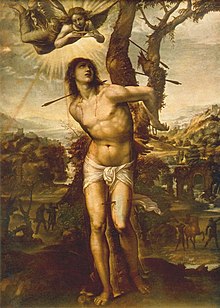Sebastian | |
|---|---|
 Martyrdom of Saint Sebastian, by Il Sodoma, c. 1525 | |
| Captain of the Praetorian Guard Roman Soldier, Healer and Martyr | |
| Born | c. AD 255 Narbo Martius, Gallia Narbonensis, Roman Empire |
| Died | c. AD 288 (aged approximately 32) Rome, Italia, Roman Empire |
| Venerated in | |
| Major shrine | San Sebastiano fuori le mura Italy |
| Feast |
|
| Attributes | Tied to a post, pillar or a tree, shot by arrows |
| Patronage | Soldiers; plague-stricken; archers; disabled peoples; athletes; cyclists; Negombo, Sri Lanka; Archdiocese of Lipa; Diocese of Tarlac; Diocese of Bacolod; Chiapa de Corzo, Mixtlán, Mexico; Rio de Janeiro, Brazil; Lumban, Laguna, Philippines; Borbon, Cebu, Philippines; Pucallpa, Peru; Taquaritinga, Brazil; Ribeirão Preto, Brazil; Győr, Hungary; Cusco, Peru; Loja, Ecuador; Rome, Italy |
Sebastian (Latin: Sebastianus; c. AD 255 – c. AD 288) was an early Christian saint and martyr. According to traditional belief, he was killed during the Diocletianic Persecution of Christians. He was initially tied to a post or tree and shot with arrows, though this did not kill him. He was, according to tradition, rescued and healed by Irene of Rome, which became a popular subject in 17th-century painting. In all versions of the story, shortly after his recovery he went to Diocletian to warn him about his sins, and as a result was clubbed to death.[1][2] He is venerated in the Catholic Church and the Orthodox Church.
The oldest record of the details of Sebastian's martyrdom is found in the Chronograph of 354, which mentions him as a martyr, venerated on January 20. He is also mentioned in a sermon on Psalm 118 by 4th-century bishop Ambrose of Milan: in his sermon, Ambrose stated that Sebastian came from Milan and that he was already venerated there at that time. The full account of his martyrdom comes from the Passio Sancti Sebastiani, a 5th-century text written by an anonymous author, possibly Arnobius the Younger.
Sebastian is a popular male saint, especially today among athletes.[3][4] In medieval times, he was regarded as a saint with a special ability to intercede to protect from plague, and devotion to him greatly increased when plague was active.
- ^ Cite error: The named reference
independentwas invoked but never defined (see the help page). - ^ Fr. Paolo O. Pirlo, SHMI (1997). "St. Sebastian". My First Book of Saints. Holy Mary Immaculate – Quality Catholic Publications. pp. 22–23. ISBN 971-91595-4-5.
- ^ "About St Sebastian – Associated & Catholic Colleges of WA". www.accsport.asn.au. Retrieved 3 December 2017.
- ^ White, Jackie. "The Patron Saint of Sports". Archived from the original on 4 August 2017. Retrieved 3 December 2017.